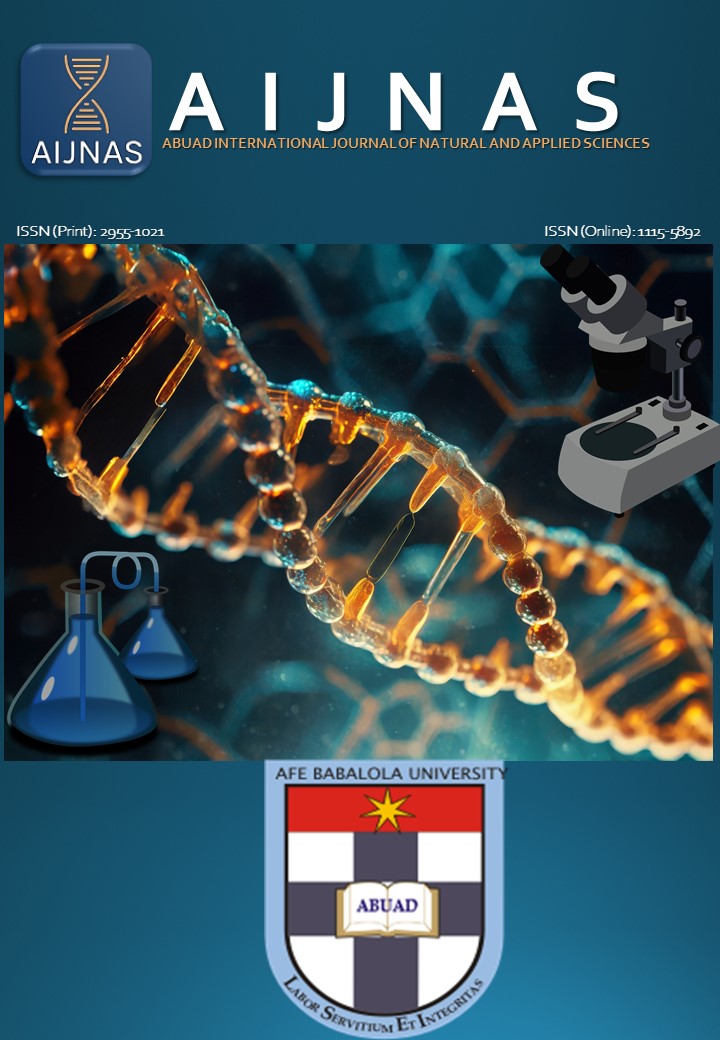Sphenocentrum jollyanum furanoditerpenes activates Glucagon-like peptide 1 receptor (GLP-1R): a computational evaluation
Main Article Content
Abstract
Sphenocentrum jollyanum is a major bio-resource used in the folkloric treatment of diabetes, unfortunately without knowledge of how or the mechanism of action. The present study focuses on using molecular docking to identify the component responsible for the anti-diabetic claim of the fruit as well as check the ADMET properties of the phytochemicals. A library of 23 phytochemicals that have been previously characterized from Sphenocentrum jollyanum fruit was generated and docked, using Autodock Vina, into 3D structures of dual-specificity tyrosine phosphorylation regulated kinase 1a (DYRK1A), peroxisome proliferator-activated receptor alpha (PPAR-α), peroxisome proliferator-activated receptor gamma (PPAR-γ), pancreatic alpha-amylase, dipeptidyl peptidase 4 (DPP4), glucagon-like peptide 1 receptor (GLP-1R), renal sodium-dependent glucose transporter (SGLUT 2). From the docking result, GLP-1R was identified as a major target for two key S. jollyanum furanoditerpenes (columbin and isocolumbin) with docking scores of -10.7 and -10.9 Kcal/mol respectively while the reference ligand (danuglipron) characterized with the GLP-1R had a score of -11.0 Kcal/mol. The protein-ligand interaction between columbin and GLP-1R showed several interactions such as hydrogen bond (H-bond), hydrophobic interactions and salt bridges, all within the extracellular domain (ECD), transmembrane domain (TM) of the receptor which is similar to that of danuglipron. Also, the ADMET profiling result was favourable as both ligands (columbin and isocolumbin) passed the Lipinski rule of 5. The results suggest that columbin identified from the docking result is most likely responsible for the antidiabetic claim of Sphenocentrum jollyanum, further investigation is needed to ascertain this claim.
Downloads
Article Details

This work is licensed under a Creative Commons Attribution-NonCommercial-NoDerivatives 4.0 International License.
Authors hold the copyright of all published articles except otherwise stated.
References
Alvariño, R., Alfonso, A., Pech-Puch, D., Gegunde, S., Rodríguez, J., Vieytes, M. R., Jiménez, C., and Botana, L. M. (2022). Furanoditerpenes from Spongia (Spongia) tubulifera Display Mitochondrial-Mediated neuroprotective Effects by Targeting Cyclophilin D. ACS Chemical Neuroscience, 13(16), 2449-2463. https://doi.org/10.1021/acschemneuro.2c00208
Andersen, A., Lund, A., Knop, F. K., and Vilsbøll, T. (2018). Glucagon-like peptide 1 in health and disease. In Nature Reviews Endocrinology (Vol. 14, Issue 7, pp. 390-403). Nature Publishing Group. https://doi.org/10.1038/s41574-018-0016-2
Bunally, S. B., Luscombe, C. N., and Young, R. J. (2019). Using Physicochemical Measurements to Influence Better Compound Design. In SLAS Discovery (Vol. 24, Issue 8, pp. 791-801). SAGE Publications Inc. https://doi.org/10.1177/2472555219859845
Dahlén, A. D., Dashi, G., Maslov, I., Attwood, M. M., Jonsson, J., Trukhan, V., and Schiöth, H. B. (2022). Trends in Antidiabetic Drug Discovery: FDA Approved Drugs, New Drugs in Clinical Trials and Global Sales. Frontiers in Pharmacology, 12.
https://doi.org/10.3389/fphar.2021.807548
Kawai, T., Sun, B., Yoshino, H., Feng, D., Suzuki, Y., Fukazawa, M., Nagao, S., Wainscott, D. B., Showalter, A. D., Droz, B. A., Sun Kobilka, T., Coghlan, M. P., Willard, F. S., Kawabe, Y., Kobilka, B. K., Sloop, K. W., Allen, J., and Ernst, O. P. (n.d.). Structural basis for GLP-1 receptor activation by LY3502970, an orally active nonpeptide agonist. https://doi.org/10.1073/pnas.2014879117/-/DCSupplemental
Moody, J. O., Robert, V. A., Connolly, J. D., and Houghton, P. J. (2006). Anti-inflammatory activities of the methanol extracts and an isolated furanoditerpene constituent of Sphenocentrum jollyanum Pierre (Menispermaceae). Journal of Ethnopharmacology, 104(1-2), 87-91. https://doi.org/10.1016/j.jep.2005.08.051
Nauck, M. A., Quast, D. R., Wefers, J., and Meier, J. J. (2021). GLP-1 receptor agonists in the treatment of type 2 diabetes - state-of-the-art. Molecular Metabolism, 46, 101102.
https://doi.org/10.1016/j.molmet.2020.101102
Noor, H., Hammonds, P., Sutton, R., and Ashcroft, S. J. H. (n.d.). The hypoglycaemic and insulinotropic activity of Tinospora crispa: studies with human and rat islets and HIT-T15 B cells.
Odoemelam, C. S., Hunter, E., Simms, J., Ahmad, Z., Chang, M.-W., Percival, B., Williams, I. H., Molinari, M., Kamerlin, S. C. L., and Wilson, P. B. (2022). In Silico Ligand Docking Approaches to Characterise the Binding of Known Allosteric Modulators to the Glucagon-Like Peptide 1 Receptor and Prediction of ADME/Tox Properties. Applied Biosciences, 1(2), 143-162. https://doi.org/10.3390/applbiosci1020010
Pinzi, L., and Rastelli, G. (2019). Molecular docking: Shifting paradigms in drug discovery. In International Journal of Molecular Sciences (Vol. 20, Issue 18). MDPI AG.
https://doi.org/10.3390/ijms20184331
Seeliger, D., and de Groot, B. L. (2010). Ligand docking and binding site analysis with PyMOL and Autodock/Vina. Journal of Computer-Aided Molecular Design, 24(5), 417-422.
https://doi.org/10.1007/s10822-010-9352-6
Stéen, E. J. L., Vugts, D. J., and Windhorst, A. D. (2022). The Application of in silico Methods for Prediction of Blood-Brain Barrier Permeability of Small Molecule PET Tracers. In Frontiers in Nuclear Medicine (Vol. 2). Frontiers Media SA.
https://doi.org/10.3389/fnume.2022.853475
Suhartono, E., Biworo, A., Santosa, P. B., Siahaan, S. C., Marisa, D., Muthmainah, N., and Komari, N. (2022). Molecular docking studies of 4-ethyl-2-metoxyphenol and 1,3-cyclopentanedione compounds from gemor ( Nothaphoebe coriacea) with glucagon like-peptide-1 (GLP-1) receptor. IOP Conference Series: Earth and Environmental Science, 976(1). https://doi.org/10.1088/1755-1315/976/1/012050
Torres, P. H. M., Sodero, A. C. R., Jofily, P., and Silva-Jr, F. P. (2019). Key topics in molecular docking for drug design. In International Journal of Molecular Sciences (Vol. 20, Issue 18). MDPI AG. https://doi.org/10.3390/ijms20184574
Wopara, I., Amadikwa Uwakwe, A., and Uchechukwu Modo, E. (2018). Possible effect of Sphenocentrum jollyanum, Baphia nitida and seeds of Pinus koraiensis and sildenafil on sodium, potassium, urea and creatinine levels of albino rats. International Journal of Biology Research, 3(2), 45-50. www.biologyjournal.in




